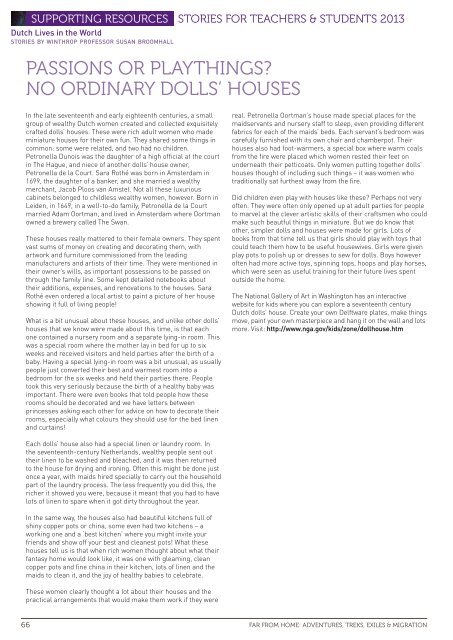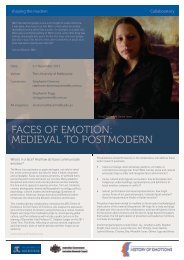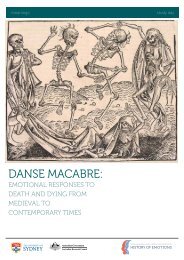Download our K-12 education pack - ARC Centre of Excellence for ...
Download our K-12 education pack - ARC Centre of Excellence for ...
Download our K-12 education pack - ARC Centre of Excellence for ...
Create successful ePaper yourself
Turn your PDF publications into a flip-book with our unique Google optimized e-Paper software.
Supporting Res<strong>our</strong>ces stories <strong>for</strong> teachers & students 2013<br />
Dutch Lives in the World<br />
stories by winthrop pr<strong>of</strong>essor susan broomhall<br />
Passions or Playthings<br />
No Ordinary Dolls’ Houses<br />
In the late seventeenth and early eighteenth centuries, a small<br />
group <strong>of</strong> wealthy Dutch women created and collected exquisitely<br />
crafted dolls’ houses. These were rich adult women who made<br />
miniature houses <strong>for</strong> their own fun. They shared some things in<br />
common: some were related, and two had no children.<br />
Petronella Dunois was the daughter <strong>of</strong> a high <strong>of</strong>ficial at the c<strong>our</strong>t<br />
in The Hague, and niece <strong>of</strong> another dolls’ house owner,<br />
Petronella de la C<strong>our</strong>t. Sara Rothé was born in Amsterdam in<br />
1699, the daughter <strong>of</strong> a banker, and she married a wealthy<br />
merchant, Jacob Ploos van Amstel. Not all these luxurious<br />
cabinets belonged to childless wealthy women, however. Born in<br />
Leiden, in 1649, in a well-to-do family, Petronella de la C<strong>our</strong>t<br />
married Adam Oortman, and lived in Amsterdam where Oortman<br />
owned a brewery called The Swan.<br />
These houses really mattered to their female owners. They spent<br />
vast sums <strong>of</strong> money on creating and decorating them, with<br />
artwork and furniture commissioned from the leading<br />
manufacturers and artists <strong>of</strong> their time. They were mentioned in<br />
their owner’s wills, as important possessions to be passed on<br />
through the family line. Some kept detailed notebooks about<br />
their additions, expenses, and renovations to the houses. Sara<br />
Rothé even ordered a local artist to paint a picture <strong>of</strong> her house<br />
showing it full <strong>of</strong> living people!<br />
What is a bit unusual about these houses, and unlike other dolls’<br />
houses that we know were made about this time, is that each<br />
one contained a nursery room and a separate lying-in room. This<br />
was a special room where the mother lay in bed <strong>for</strong> up to six<br />
weeks and received visitors and held parties after the birth <strong>of</strong> a<br />
baby. Having a special lying-in room was a bit unusual, as usually<br />
people just converted their best and warmest room into a<br />
bedroom <strong>for</strong> the six weeks and held their parties there. People<br />
took this very seriously because the birth <strong>of</strong> a healthy baby was<br />
important. There were even books that told people how these<br />
rooms should be decorated and we have letters between<br />
princesses asking each other <strong>for</strong> advice on how to decorate their<br />
rooms, especially what col<strong>our</strong>s they should use <strong>for</strong> the bed linen<br />
and curtains!<br />
real. Petronella Oortman’s house made special places <strong>for</strong> the<br />
maidservants and nursery staff to sleep, even providing different<br />
fabrics <strong>for</strong> each <strong>of</strong> the maids’ beds. Each servant’s bedroom was<br />
carefully furnished with its own chair and chamberpot. Their<br />
houses also had foot-warmers, a special box where warm coals<br />
from the fire were placed which women rested their feet on<br />
underneath their petticoats. Only women putting together dolls’<br />
houses thought <strong>of</strong> including such things – it was women who<br />
traditionally sat furthest away from the fire.<br />
Did children even play with houses like these Perhaps not very<br />
<strong>of</strong>ten. They were <strong>of</strong>ten only opened up at adult parties <strong>for</strong> people<br />
to marvel at the clever artistic skills <strong>of</strong> their craftsmen who could<br />
make such beautful things in miniature. But we do know that<br />
other, simpler dolls and houses were made <strong>for</strong> girls. Lots <strong>of</strong><br />
books from that time tell us that girls should play with toys that<br />
could teach them how to be useful housewives. Girls were given<br />
play pots to polish up or dresses to sew <strong>for</strong> dolls. Boys however<br />
<strong>of</strong>ten had more active toys, spinning tops, hoops and play horses,<br />
which were seen as useful training <strong>for</strong> their future lives spent<br />
outside the home.<br />
The National Gallery <strong>of</strong> Art in Washington has an interactive<br />
website <strong>for</strong> kids where you can explore a seventeenth century<br />
Dutch dolls’ house. Create y<strong>our</strong> own Delftware plates, make things<br />
move, paint y<strong>our</strong> own masterpiece and hang it on the wall and lots<br />
more. Visit: http://www.nga.gov/kids/zone/dollhouse.htm<br />
Each dolls’ house also had a special linen or laundry room. In<br />
the seventeenth-century Netherlands, wealthy people sent out<br />
their linen to be washed and bleached, and it was then returned<br />
to the house <strong>for</strong> drying and ironing. Often this might be done just<br />
once a year, with maids hired specially to carry out the household<br />
part <strong>of</strong> the laundry process. The less frequently you did this, the<br />
richer it showed you were, because it meant that you had to have<br />
lots <strong>of</strong> linen to spare when it got dirty throughout the year.<br />
In the same way, the houses also had beautiful kitchens full <strong>of</strong><br />
shiny copper pots or china, some even had two kitchens – a<br />
working one and a ‘best kitchen’ where you might invite y<strong>our</strong><br />
friends and show <strong>of</strong>f y<strong>our</strong> best and cleanest pots! What these<br />
houses tell us is that when rich women thought about what their<br />
fantasy home would look like, it was one with gleaming, clean<br />
copper pots and fine china in their kitchen, lots <strong>of</strong> linen and the<br />
maids to clean it, and the joy <strong>of</strong> healthy babies to celebrate.<br />
These women clearly thought a lot about their houses and the<br />
practical arrangements that would make them work if they were<br />
66 FAR FROM HOME: ADVENTURES, TREKS, EXILES & MIGRATION












